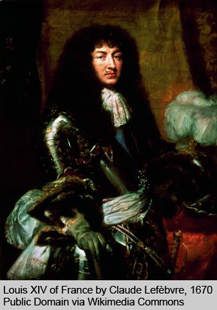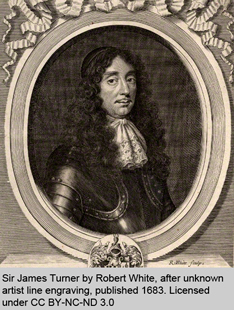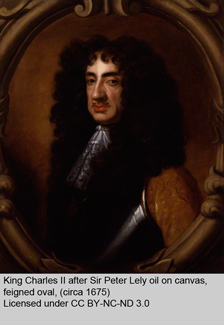 King Louis XIV of France (1638–1715) was one of the individuals central to the bayonet’s becoming a successful military weapon. The portrait at left is in the collection of the New Orleans Museum of Art in Louisiana (which was named after Louis XIV). Louis XIV's reign of 72 years remains the longest of any major European monarch. The period and length of his reign uniquely positioned him to have a remarkable influence on the bayonet’s development.
King Louis XIV of France (1638–1715) was one of the individuals central to the bayonet’s becoming a successful military weapon. The portrait at left is in the collection of the New Orleans Museum of Art in Louisiana (which was named after Louis XIV). Louis XIV's reign of 72 years remains the longest of any major European monarch. The period and length of his reign uniquely positioned him to have a remarkable influence on the bayonet’s development.
When he became King in 1643, French soldiers still wore armor. By the time of his death, in 1715, nearly all vestiges of medieval warfare were gone and France had the world’s most modern army. In 1671, he was the first to formally introduce the bayonet into a major army. He presided during the 25 year quest to find an alternative to the pike. He played a significant role in the adoption of the socket bayonet and finally abolished use of the pike in the French Army in 1704.
Louis XIV’s introduction of the bayonet in 1671 was documented by the French historian Fr. Gabriel Daniel. Daniel was a Jesuit Scholar whom Louis XIV appointed historiographer of France. In his 1721 book, Histoire de la Milice Françoise, Et des changemens qui s'y font faits depuis l'Etablissement de la Monarchie Françoife dans les Gaules, jusqúà la fin de Régne De Louis le Grand (History of the Militia of France, and changes made to it since the founding of the French monarchy in Gaul, until the end of the Reign of Louis the Great), Daniel writes of the King’s indicating that:
"This weapon is very new to the troops. I, the King, first gave this weapon to the Fusileers Regiment, created in 1671, and since called the Royal Artillery Regiment. The soldiers of this regiment carry the bayonet in a small sleeve, as with the sword. I have since given some to other regiments for the same purpose, that is, to put at the end of the musket on occasion." [View an image of this passage from Fr. Daniel's book.]
French writer, historian, and philosopher Voltaire also writes of this as well:
"The use of the bayonet at the end of the musket, is an institution of the King’s. Before this time it was used occasionally, and some companies only had this weapon; there was no uniform usage nor exercise with it: all was left to the General’s discretion. The pike was looked upon as the most formidable weapon. The first regiment which had bayonets, and was trained to this exercise, was that of the Fusiliers, established in the year 1671." [View an image of this passage from Voltaire's writings.]
 The bayonet was not without its advocates in Britain. Sir James Turner, in volume two of his 1683 book, Pallas Armata: Military Essayes of the Ancient Grecian, Roman, and Modern Art of War. Written in the Years 1670 and 1671, writes that:
The bayonet was not without its advocates in Britain. Sir James Turner, in volume two of his 1683 book, Pallas Armata: Military Essayes of the Ancient Grecian, Roman, and Modern Art of War. Written in the Years 1670 and 1671, writes that:
"Our present militia acknowledging no other weapon for the light armed infantry, but the musket and the sword, and this last I have seen sometimes laid aside for a time, that it might not impede the manageing the musket by its embaraas [awkwardness]. And indeed when musketeers have spent their powder, and come to blows, the butt-end of their musket may do an enemy more hurt than those despicable swords which most musketeers wear at their sides. In such medleys [melees], knives whose blades are one foot long, made both for cutting and thrusting (the haft being made to fit the bore of the musket), will do more execution than either sword or butt of musket." [View an image of this passage from Turner's book.]
 Britain’s King Charles II followed Louis XIV's example, officially introducing the bayonet into the British Army in April 1672. In raising a regiment of Dragoons, he issued the following order:
Britain’s King Charles II followed Louis XIV's example, officially introducing the bayonet into the British Army in April 1672. In raising a regiment of Dragoons, he issued the following order:
“Our will and pleasure is that a Regiment of Dragoons which we established and ordered to be raised in Twelve Troopes of four score in each besides officers, who are to be under the command of Our most deare and most intirely beloved Cousin, Prince Rupert, shall be armed out of Our stoares remaining within Our office of the Ordinance, as followeth: that is to say, three corporalls, two serjeants, the gentlemen-at-arms, and twelve souldiers of each of the said twelve Troopes, are to have and carry each of them one halbard, and one case of pistolls with holsters; and the rest of the souldiers of the several Troopes aforesaid are to have and carry each of them one match-locke musquet with a collar of bandaliers, and also to have and to carry one bayonett or greate knife. That each lieutenant have and carry one partizan; and that two drums be delivered out for each Troope of the said Regiment.” [View an image of the King's directive.]
Next: 1680s—The Military Plug Bayonet
Back: 1640s—First Military Use of the Bayonet
Return to History of the Bayonet Index
© Ralph E. Cobb 2009 All Rights Reserved



